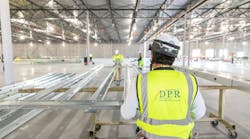Facebook Showcases its 40 Million Square Feet of Global Data Centers
Facebook has invested more than $16 billion in building and operating its data centers in the United States, the company said yesterday as it unveiled a new web site showcasing its global data center infrastructure.
The site maps the locations of the company’s 18 data centers, which upon completion will span 40 million square feet of data center space. along with 52 solar power arrays and 15 wind farms providing renewable energy to support its online operations, and 9 water conservation projects.
The company’s first cloud campus in Prineville, Oregon features its largest deployment of servers, with plans for nine data center buildings and 4.6 million square feet of capacity. Facebook also has some of its largest concentrations of IT infrastructure in the Midwest, with plans for 4.1 million square feet of data centers in Altoona, Iowa and 3.6 million square feet in Sarpy, Nebraska.
The web site outlines 34.2 million square feet of campus capacity in the U.S., and 5.4 million square feet (499,000 square meters) of global space planned for sites in Ireland, Sweden, Denmark and Singapore.
Facebook is following the the lead of other hyperscale operators in creating a dedicated web presence to provide information about its data center infrastructure. These large companies are often secretive about their data center operations, but in recent years have begun to recognize the value of demystifying data centers and educating community stakeholders about the benefits of these facilities.
As huge new data center developments generate headlines, providing ready access to information about these projects has become an important in working public officials, community groups and media seeking information about what the project will mean.
- In 2012 Google offered a photo tour of its data centers titled “Where The Internet Lives,” which was soon expanded into a dedicated web site offering details about its data centers, their energy efficiency (including detailed PUE reports) and has recently been expanded to include extensive information about data center careers and a podcast series about Google’s data infrastructure.
- In about 2018, Amazon Web Services created an area of its web site offering high-level information about its data centers, with a focus on security and maintenance practices.
- Earlier this year Microsoft offered the world a look inside its cloud data centers with a new virtual tour, an immersive experience that provides a walk-through of simulated data halls, network rooms, and operations equipment yards.
Facebook’s data center site features extensive information about the economic impact of their data centers in the communities where they are located, as well as their grant programs for local schools and non-profits. The site also includes extensive information about Facebook’s climate-focused initiatives on energy efficiency, sustainability and water conservation.
About the Author



